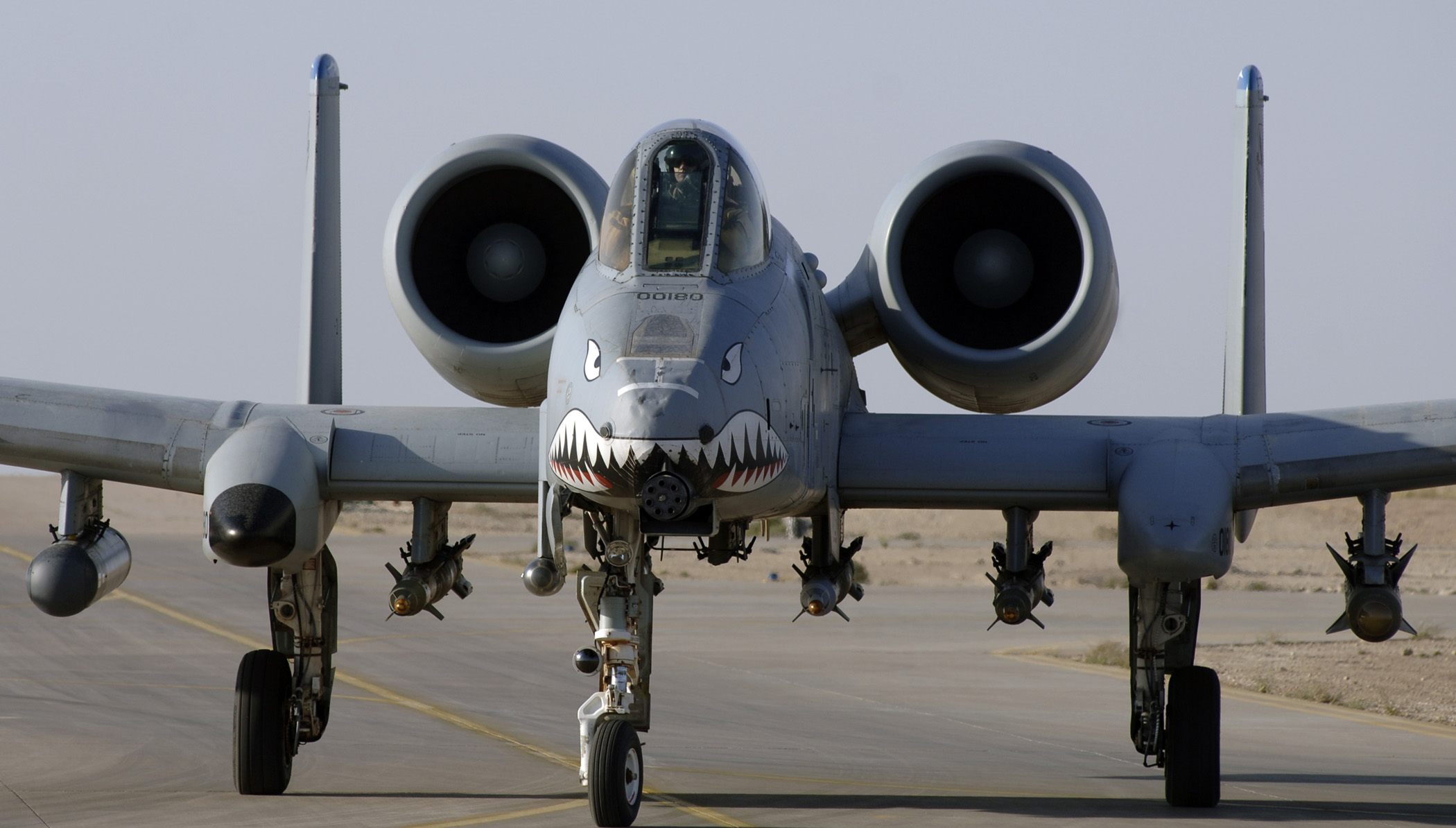A-10 Warthog Aftermath - Two intersecting lines forming an "X". Shows you how to close interactions or dismiss notifications.
Home chevron icon Indicates a drop-down section or menu, and sometimes previous/next navigation option. Collaborator of the army and defense
A-10 Warthog Aftermath

Twitter icon Stylish bird with mouth open, tweeting. LinkedIn icon Twitter The word "w". LinkedIn icon Fliboard Stylish letter F. Facebook Flipboard icon Letter F. Facebook Email Envelope icon. Shows the ability to send emails. E-mail Link Icon An image of a chain link. Represents the URL of a link to a website. Copy link
Video: This Taliban Vehicle Had A Close Encounter With A 10's Gau 8/a Avenger Cannon
An A-10C Thunderbolt II of the 23rd Fighter Group fires at a target during a February 2016 exercise at Moody Air Force Base, Georgia. DVIDS
Arguments about weapon systems tend to be circular and hard to win. Discussions about close air support, the retirement of the aging A-10 Thunderbolt II, and the entry of the F-35 Joint Strike Fighter — along with the recent prominence of the light attack experiment — continue to swirl.
But one thing can't be questioned is the death and showmanship of the A-10 GAU-8 Avenger's 30mm seven-barrel Gatling gun.
This video was posted on January 24 at the Office of Public Affairs of the U.S. Air Force Central Command. It is credited to the 94th Airlift Wing which, oddly enough, is primarily an airlift wing. The Defense Video Distribution System (DVIDS) did not give a reason why this video was released via the airlift wing, but it was likely due to logistics.
Early On, The A 10 Warthog's Legendary Gun Was Both A Blessing And A Curse
Video recorded from an unknown camera platform shows an Air Force A-10 Thunderbolt II carrying out an attack on a Taliban vehicle fleeing an attack site in Kandahar province on Jan. 24. The insurgents in the vehicle were armed with 12.7 mm DShK heavy machine guns, which had been used moments earlier during attacks on Afghans.
The video is relevant to the close discussion of support for several reasons. First, it demonstrates the accuracy of the GAU-8 weapon system, at least in this one example. It can be seen that two 30 mm rounds penetrated the hood of the vehicle, then one penetrated the roof of the driver's cabin, and the fourth bullet went through the roof of the passenger compartment of the vehicle. Considering the speed of the vehicle and the fact that the A-10 is obviously also moving, this is an extraordinary level of accuracy.
Needless to say, more than one bullet left the cannon, and there appear to be two separate shots in the video.
The video also suggests an interesting scenario where if the A-10 attacked from 5,000 feet or higher (especially if it had to stay out of the cover of anti-aircraft systems like the Manpads), then the image could have been taken from another. aircraft, not the A-10 that struck. A likely candidate is a remote-controlled aircraft that provides intelligence, surveillance and reconnaissance, and then perhaps also targeting for attack aircraft.
A 10 Warthog Gau 8 Avenger 30mm Gatling Gun And A Round Next To It
While we don't know if that's the case with this video, it's pretty common practice to suggest it.
While supporters of the "save the A-10" movement are unlikely to be swayed by such a video - and it dates back to the first operational use of the A-10 in 1991 - they remain convincing. According to a 1993 report, during its first operational use in the Gulf War, the A-10 was deemed capable of destroying approximately 900 Iraqi tanks, 2,000 unarmored military vehicles and 1,200 artillery pieces. the ability to see if a different metal could be used in a new round.
The US Air Force wants to purchase new ammunition for the GAU-8/A Avenger cannon of the iconic A-10 Warthog and is considering purchasing ammunition with an armor-piercing core that does not contain the controversial depleted uranium. Among the changes in the spotlight in the US military. towards preparations for luxury conflicts
Against conventional adversaries, the service must replace its existing supply of tank-busting ammunition as it nears its end-of-life.
Round In 60 Seconds: Why The A 10 Warthog Is So Feared
Military.com was the first to report on possible changes to the design of the bullet. The simplest alternative available to the Air Force is to replace the depleted uranium in the armor-piercing round, known as PGU-14/B, with another solid metal such as tungsten. The DU round is one of the two main combat rounds for the A-10, the other being the PGU-13/B high-explosive incendiary round. The two are usually mixed together in aircraft magazines at a ratio of five armor-piercing rounds to one high-explosive round.
"There's been a lot of discussion about whether we're going to use depleted uranium or tungsten penetrators again," Bob DuPont, a member of the 780th Test Squadron at Eglin Air Force Base, Florida, told Military.com in early May 2018. "We'll try to keep the same weight, but it will have less penetration due to the density of the material, DU [depleted uranium] is denser than tungsten."
Currently, the PGU-14/B project represents a real projectile with a solid depleted uranium penetrator housed in an aluminum casing. A lightweight "front fender" that keeps the entire craft aerodynamically stable until it reaches its destination, where momentum takes it forward to penetrate armor and other obstacles. In addition, DU is pyrophoric, meaning it ignites spontaneously when exposed to normal air, giving the round a secondary combustion effect without the need for any other filler material.

Diagram showing the elements of the shell on the PGU-14/B projectile. "Heavy metal" in this case refers to the core of DU., USN
Watch An A 10 Warthog Decimate A Taliban Vehicle In Afghanistan
Bullets can penetrate inches of rolled homogeneous steel armor even at over 1,000 yards. The A-10 also has the advantage of being able to attack from sharp angles or from behind vehicles to focus fire on areas that are normally less protected. Because they fly at high speeds and don't rely on explosives, missiles like the PGU-14/B are also less vulnerable to active defense systems.
But rounds are approaching a point where they may no longer be safe to use. According to Military.com, the average age of a PGU-14/B cartridge is 32 years. In a rapid-firing system such as the GAU-8/A, which fires around 70 rounds per second, if the primer and fuel explode too slowly, it can damage the gun and the aircraft as a whole.
"I have 4.5 milliseconds from the start of the round to get the bullet out of the barrel," DuPont told Military.com. "Anything above six milliseconds is catastrophic to this system."
Now that the bullet needs replacing, it's time to see if other bullet components need updating. And while it has been used for decades, depleted uranium bullets are increasingly controversial.
A 10 Thunderbolt Ii
A byproduct of nuclear reactor fuel production, DU is not only denser than similar metals such as tungsten, but also much cheaper and more readily available. The US Army used this material to construct both armor penetrators
It also has mild radioactivity - it only produces alpha particles that can be blocked by clothing and even human skin - and there are studies suggesting it may be a toxic carcinogen. The second issue is more relevant to operations, especially since the penetrators break apart and burn on impact, potentially contaminating soil and groundwater or simply throwing DU dust into the air.
In particular, in Iraq, where US military units used large amounts of DU rounds during the 1991 and 2003 invasions, there was an increase in certain types of birth defects and cancers. Veterans of the first Gulf War cite exposure as one of the potential causes of the so-called Gulf War syndrome. The US government says there is no conclusive evidence linking the celebrations to health problems, which is true.
At the same time, however, Iraq has been a near-permanent conflict zone for 15 years, making it difficult for scientists to access and conduct long-term impact studies that could solve the problem once and for all. At the same time, the U.S. military is only slowly beginning to release its own data on how many rounds were fired and where, which will help scientists determine if the correlation is indeed evidence of causation.
Inside The Cockpit Of America's $18million Tank Busting A 10c Thunderbolt Ii Aircraft
"So far, no health problems related to DU exposure have been identified in veterans exposed to DU," said the U.S. Department of Veterans Affairs. on its own website dedicated to this topic. "Scientists and clinicians continue to monitor the health of these veterans."
Whether or not the health concerns are as real and tangible as DU's critics claim, the bullet continues to be a hot topic. For a while it looked like this could also be increasingly questioned.
After the terrorist attacks of September 11, the US military focuses mainly on fighting terrorists and insurgents.
Rc a 10 warthog, a 10 warthog round, a 10 warthog shirt, a 10 warthog toy, lego a 10 warthog, a 10 warthog plane, a 10 warthog history, revell a 10 warthog, a 10 warthog poster, a 10 warthog, a 10 warthog picture, a 10 warthog stickers

0 Comments